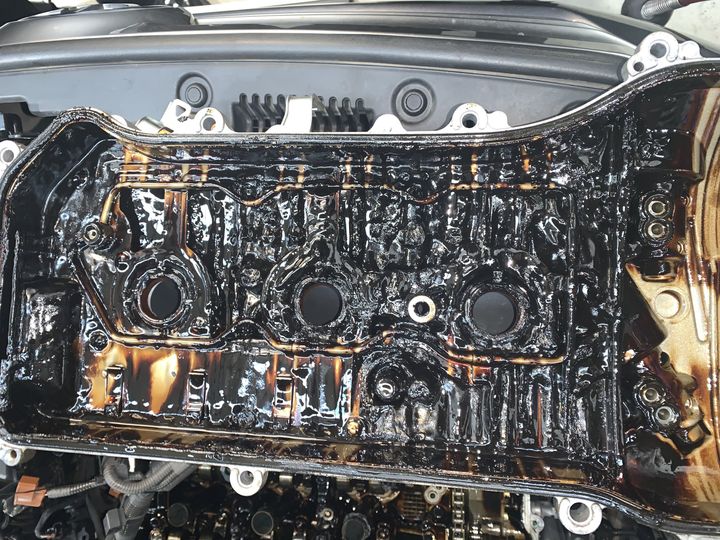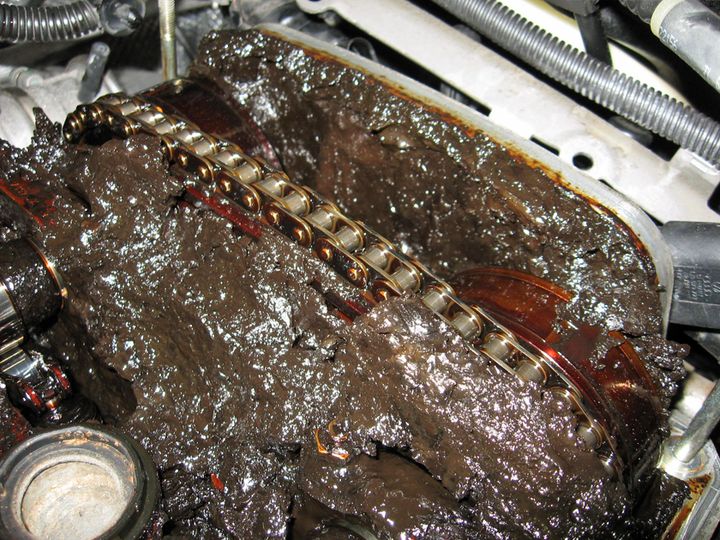


As an experienced mechanic, I've encountered countless cases of engine oil sludge buildup, and let me tell you, it's a problem that can wreak havoc on your vehicle's performance and longevity. Imagine a thick, gooey substance clogging up the intricate pathways of your engine, hindering the flow of vital lubricants and causing excessive wear and tear. It's a scenario that no car owner wants to face, but unfortunately, it's a common issue that requires prompt attention.

In this article, I'll share my expertise on the causes of engine oil sludge, how to detect it, and most importantly, the steps you can take to clean it up and prevent future buildup. Buckle up, because we're about to dive into the nitty-gritty of engine maintenance and preservation.
Before we tackle the cleaning process, it's essential to understand what causes engine oil sludge in the first place. Here are the primary culprits:
| Cause | Description |
|---|---|
| Infrequent Oil Changes | Neglecting to change your engine oil at the recommended intervals is one of the biggest contributors to sludge buildup. As the oil ages, it loses its lubricating properties and becomes contaminated with combustion byproducts, setting the stage for sludge formation. |
| Low-Quality Oil | Using low-quality or incorrect viscosity oil can accelerate the breakdown of the oil and promote sludge formation. High-quality oils with robust detergent additives help prevent sludge buildup by keeping contaminants suspended and preventing them from sticking to engine components. |
| Short-Trip Driving | If your daily commute consists of short trips without allowing the engine to reach optimal operating temperatures, you're creating a breeding ground for sludge. The engine doesn't get hot enough to burn off moisture and contaminants, leading to their accumulation and eventual sludge formation. |
| Excessive Heat | Extreme temperatures can also cause the oil to oxidize and break down more rapidly, leading to sludge formation. This can be caused by factors such as overheating, towing heavy loads, or driving in hot climates. |
| Contaminants | Various contaminants, such as dust, dirt, and combustion byproducts (e.g., soot, carbon), can mix with the oil and contribute to sludge formation. |
| Coolant or Water Contamination | If coolant or water leaks into the engine oil, it can cause the oil to break down and form sludge. It's a chemical reaction gone wrong, and the result is a thick, gooey mess that can wreak havoc on your engine's internal components. |
Now that you know the causes, it's time to learn how to detect engine oil sludge before it becomes a major problem. Here are the steps I recommend:
Check the engine oil level and condition. If the oil appears thick, dark, or has a milky appearance, it may be contaminated with sludge. This is a telltale sign that something's amiss.
Remove the valve cover and inspect the engine's internal components. Sludge often accumulates on the valve train, cylinder head, and oil pan. If you see a thick, gooey buildup, it's time to take action.
Watch for warning signs. Decreased fuel efficiency, low oil pressure, engine knocking or ticking noises, and the check engine light illuminating can all be indicators of sludge buildup. Don't ignore these red flags – they're your engine's way of crying for help.
Alright, you've identified the problem, and now it's time to roll up your sleeves and get to work. Here's my step-by-step guide to cleaning engine oil sludge:

Prepare the engine. Ensure it's cool and parked on a level surface. Disconnect the battery and jack up the car for better access. Safety first, folks!
Drain the old engine oil and replace the oil filter. This is the first step in getting rid of the contaminated oil and sludge buildup.
Add an engine flush solvent. These solvents are designed to help break down the sludge, making it easier to remove. Follow the recommended duration for the solvent to work its magic.
Drain the solvent and flush the engine. Use hot water or a degreaser solution to flush out the loosened sludge and contaminants.
Get scrubbing. For stubborn sludge buildup, you may need to break out the wire brush, pressure washer, or steam cleaner to really get in there and clean those hard-to-reach areas.
Replace the oil and filter. Once you've given your engine a thorough cleaning, it's time to replenish it with fresh, high-quality engine oil and a new filter. This is like giving your engine a fresh start.
Now, I'll be honest with you – in cases of severe sludge buildup, professional engine cleaning or disassembly may be required for a truly thorough cleaning. But for most cases, following these steps should do the trick.
| Method | Description |
|---|---|
| Basic Engine Flush and Oil Change | This involves draining the old oil, replacing the filter, adding an engine flush solvent, and then flushing the engine with hot water or a degreaser solution before refilling with fresh oil. |
| Professional Engine Cleaning | For more severe cases, a professional mechanic may use specialized equipment and techniques to thoroughly clean the engine's internal components, such as hot tank cleaning, ultrasonic cleaning, or chemical dipping. |
| Engine Disassembly | In extreme cases, the engine may need to be partially or fully disassembled to access and clean hard-to-reach areas or components that are heavily clogged with sludge. |
Cleaning up sludge is one thing, but preventing it from happening again is the real key to maintaining a healthy engine. Here are my top tips for keeping sludge at bay:
Adhere to the manufacturer's recommended oil change intervals. This is the golden rule of engine maintenance. Don't skimp on those oil changes, and use high-quality engine oil with robust detergent additives.
Avoid excessive idling or short-trip driving. These habits can contribute to sludge formation by not allowing the engine to reach optimal operating temperatures.
Regularly inspect and maintain the engine's cooling system, crankcase ventilation system, and other components. Any issues with these systems can lead to sludge buildup, so stay on top of them.
Consider using an oil catch can or air-oil separator. These devices can help prevent blow-by gases from contaminating the engine oil, reducing the risk of sludge formation.
Address any coolant or water leaks promptly. Contamination of the engine oil with coolant or water can accelerate sludge buildup, so don't ignore those leaks.
| Prevention Method | Description |
|---|---|
| Regular Oil Changes | Follow the manufacturer's recommended oil change intervals and use high-quality engine oil with robust detergent additives. |
| Proper Driving Habits | Avoid excessive idling or short-trip driving, which can contribute to sludge formation by not allowing the engine to reach optimal operating temperatures. |
| Maintenance of Engine Systems | Regularly inspect and maintain the engine's cooling system, crankcase ventilation system, and other components that can contribute to sludge buildup. |
| Oil Catch Can or Air-Oil Separator | These devices can help prevent blow-by gases from contaminating the engine oil, reducing the risk of sludge formation. |
| Prompt Leak Repair | Address any coolant or water leaks promptly to prevent contamination of the engine oil, which can accelerate sludge buildup. |
Now, let's talk about the elephant in the room – the cost of cleaning engine oil sludge. The truth is, the cost can vary depending on the severity of the buildup and the method used.
A basic engine flush and oil change may cost between $100 and $300, which is a relatively affordable preventative measure. However, if the sludge buildup is severe and requires professional engine cleaning or disassembly, you could be looking at a bill ranging from $500 to $1,500 or more, depending on the extent of the work required.
| Cost Range | Description |
|---|---|
| $100 - $300 | Basic engine flush and oil change |
| $500 - $1,500+ | Professional engine cleaning or disassembly for severe sludge buildup |
While these costs may seem daunting, it's important to remember that neglecting to address engine oil sludge can lead to even more expensive repairs or even engine failure down the line. Trust me, replacing an entire engine is a cost you don't want to face.
Cleaning engine oil sludge is no easy task, but it's a necessary evil to keep your vehicle running smoothly and extend its lifespan. By understanding the causes, detecting the signs, and following the proper cleaning and prevention methods, you can save yourself from a world of headaches and costly repairs.
Remember, an ounce of prevention is worth a pound of cure. Stick to those regular oil changes, use high-quality oil, and address any issues promptly. Your engine will thank you for it, and you'll be able to enjoy a reliable, sludge-free ride for years to come.
So, take it from a seasoned mechanic – don't let engine oil sludge catch you off guard. Stay vigilant, follow the steps outlined in this article, and keep that engine running like a well-oiled machine (pun intended).
The main signs include low oil pressure, decreased fuel efficiency, engine overheating, knocking or ticking noises, and illuminated warning lights on the dashboard.
While it cannot be prevented entirely, following the recommended maintenance schedule, using high-quality oil, and addressing any leaks or faulty components can significantly reduce the risk.
The recommended interval varies, but generally, passenger cars should have an oil change every 3,000 to 5,000 miles, and trucks/SUVs every 5,000 to 7,500 miles.
Neglecting sludge buildup can lead to severe engine damage, decreased performance, and potentially complete engine failure, requiring expensive repairs or replacement.
In mild cases, a basic engine flush and oil change can help remove sludge. However, severe buildup may require professional cleaning or engine disassembly.
A basic engine flush and oil change can cost $100 to $300, while professional cleaning or disassembly for severe cases can range from $500 to $1,500 or more.
A faulty PCV valve can increase the risk of sludge buildup by allowing blow-by gases to contaminate the engine oil.
Yes, using low-quality or incorrect viscosity oil can accelerate oil breakdown and promote sludge formation.
While sludge can occur in any vehicle, older engines with higher mileage are more susceptible due to wear and tear on components like the PCV valve.
Yes, habits like excessive idling, short-trip driving, and stop-and-go traffic can contribute to sludge buildup by not allowing the engine to reach optimal operating temperatures.

Sarah isn't your average gearhead. With a double major in Mechanical Engineering and Automotive Technology, she dived straight into the world of car repair. After 15 years of turning wrenches at dealerships and independent shops, Sarah joined MICDOT to share her expertise and passion for making cars run like new. Her in-depth knowledge and knack for explaining complex issues in simple terms make her a valuable asset to our team.



